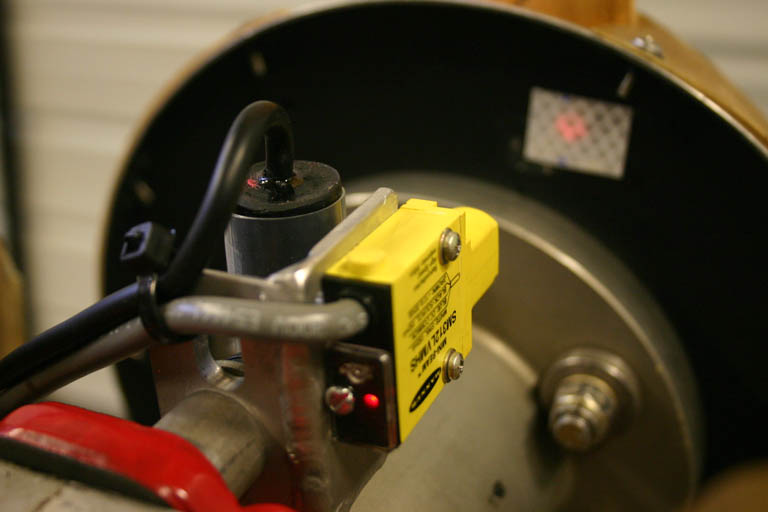
I mounted the accelerometer and optical proximity sensor the front of my Corvair engine, with the prox sensor shining on the back of the prop spinner. Here you can see the dim red glow on the reflective tape.
Created Sept 1st, 2008
I've paid $150 to have my prop balanced, and it made a huge difference that I could hardly believe. But the local guy that does it has been unable get the equipment to repeat the process, despite repeated attempts. I started thinking about buying my own, since I do so much engine and prop testing, and feel like I'm wandering in the dark with respect to vibration engine vibration.
Then I heard about the "DynaVibe", which is only $1500...a LOT cheaper than the nearest competition. It's not quite as fancy as the really expensive ones, in that it doesn't draw plots, save data to files, or do three axes, but why would I need the axis that the crank runs in? What I need is the X and Y plane that's defined by the prop, and the DynaVibe handles that nicely. It also functions as a digital tach to verify if your installed tach is accurate.

I mounted the accelerometer and optical proximity sensor the front of my Corvair engine, with the prox sensor shining on the back of the prop spinner. Here you can see the dim red glow on the reflective tape.
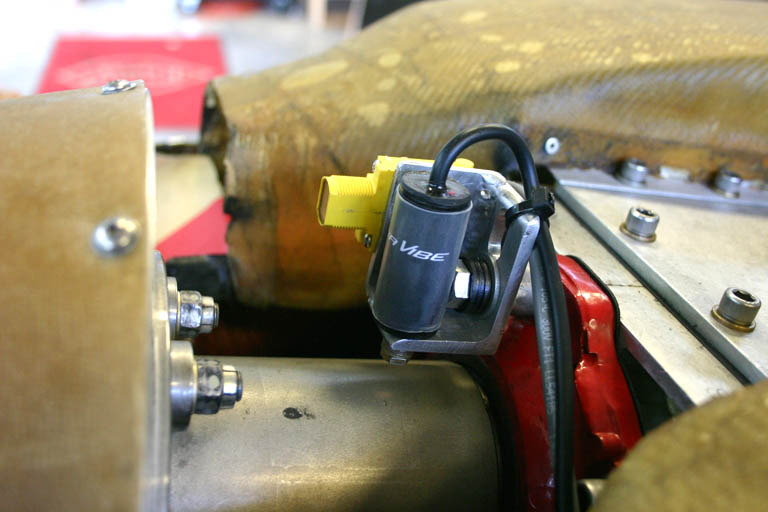
More details of the mount, which I welded (could have bolted) up out of leftover aluminum angle and plate, chopped to size with my woodworking bandsaw. I mounted the setup so it could be left in place, and data can be taken while flying. The cables are safely routed around the engine and into the cabin through the cabin heat vent.
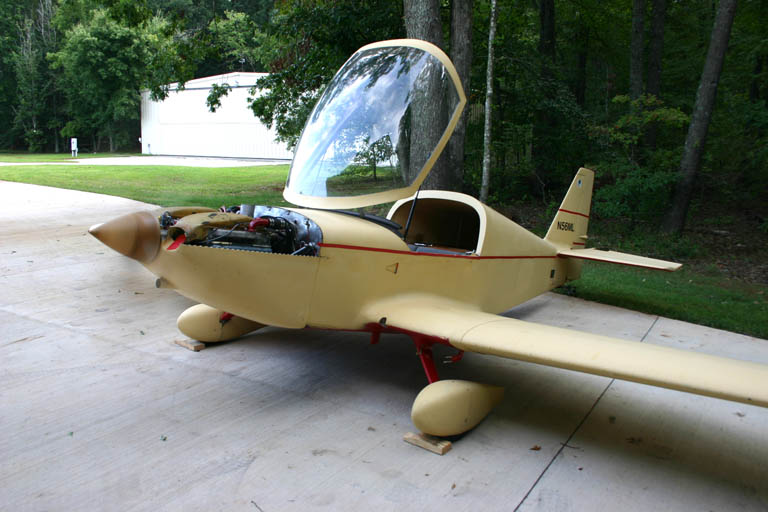
So I dragged it out, chocked the wheels, and ran it up, gathering data at various RPMs.
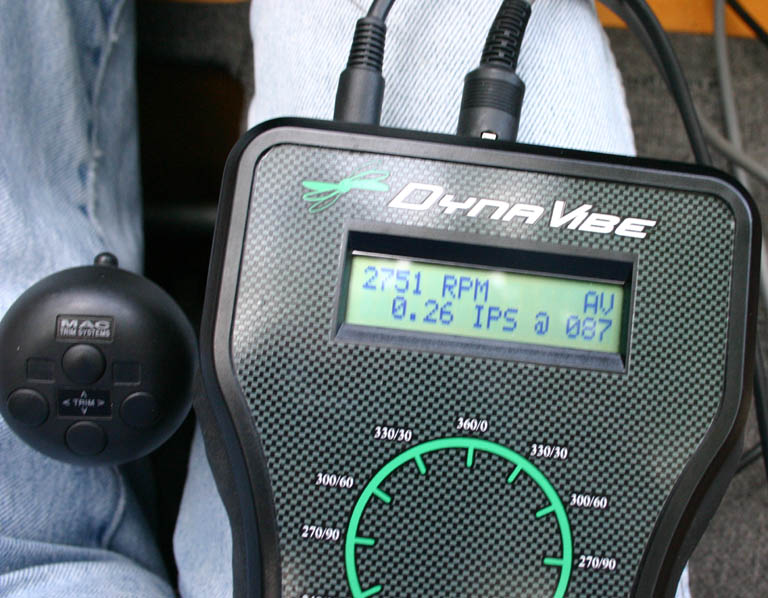
The highest vibration reading was at wide open throttle (WOT), .26 ips (inches per second) at 2750 rpm, with the heavy part located at 86 degrees from when the prop is vertical. The goal is to get it below .10, so I'm not that far out to start with. Now all I needed to do was add a small bolt and nut to the spinner backplate at the location oposite of the 87 degree point, 273 degrees. A little trial and error with washers will allow me to reduce the vibration substantially. I swapped out one of the #6 spinner screws at the 270 degree position with a longer one and a few washers stacked under the head, and almost cut the vibration level in half. Then I went flying with the DynaVibe installed, and the plane was substantially smoother, which is saying something because it was already really smooth before I started this!
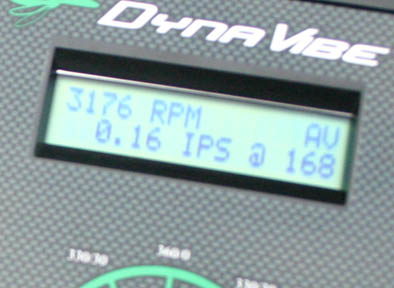
And here are the results...which is pretty good considering the higher RPM than before. Also, I was curious to see what kind of indication it would give during climbs and turns. It wouldn't be a real imbalance, but an imbalance felt by the engine due to aerodynamic and gyroscopic prop forces. The result was almost double the vibration in a climb, about half the vibration in a descent, a notable increase in vibration in left turns, and about half the vibration in right turns. I wouldn't expect a front bearing to change this behavior, but the load path will be through the case, rather than through the crank, so the comparison will be interesting.
I could have kept tweaking until I cut a lot more of what was left of the vibration, but it's probably a moot point since I'm going to install the 3100cc engine this weekend, so I quit there and headed home to work on the engine. After the 3100cc engine is installed, I'll go to a real effort to dial out the vibration. At that point I want to test the engine throughout the RPM range looking for areas of resonance that might indicate areas which should be avoided during normal flight. I haven't noticed anything of that sort in 760 hours, but the study will be entertaining, anyway. See the RPX DynaVibe website for more details on the DynaVibe...
As of November 20th I have about 42 hours on the front bearing engine, flying to the KR Gathering in Illinois and back, down to my father's grass strip in south Alabama, bumming around the local area taking sunset pictures and practicing stalls, among other things. Despite having some pretty smooth engines in the past, this is by far the smoothest engine I've ever built, due at least in part to the fact that I balanced all of the opposing piston/ring/rod combinations to within .1 grams. This engine is unbelievably smooth, and the Dynavibe proves it with a solid .02 IPS vibration level. Recall that on previous incarnations of this engine, climbing always increased the vibration level significantly, and the DynaVibe even measured a doubled level of vibration during climbs. That simply doesn't happen now. The DynaVibe (and my butt) says there is NO change in vibration levels from level flight to steep climb!
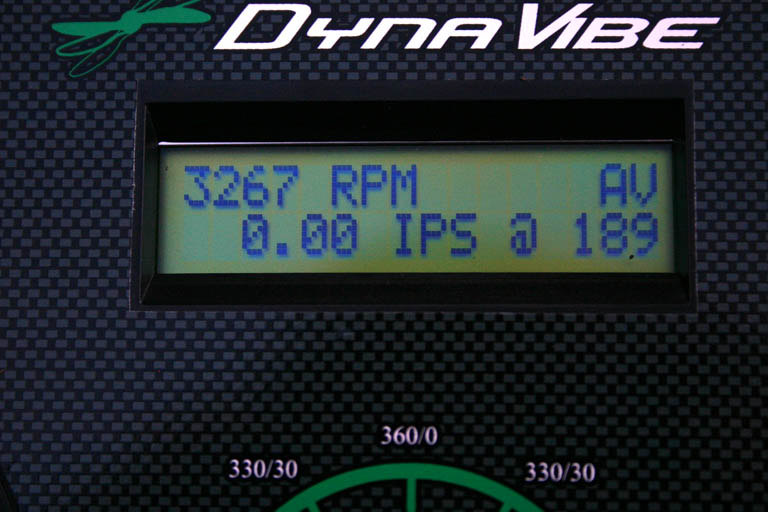
As you can see, I can achieve 0.00 IPS while flying, although it will usually bounce back and forth between 0.01, 0.00, and 0.02. This is pretty good, considering the "goal" in the manual is 0.10! Starting with an almost perfectly balanced opposed 6-cylinder Corvair probably helps!
That really surprised me, because I'd have thought the airframe would still feel the prop's vibration (caused mostly by P-factor), but with the addtion of the fifth bearing, the path would be through the case rather than through the crank nose. Instead, the vibration increase during climb is gone. My guess is now that the front bearing has eliminated the possiblity of movement, the "spring" on the front of the crank is gone, and now the descending prop blade can't make that 1000 pound airplane move at all. So the blade does some harmless wiggling in the prop arc, and the crank nose sees nothing but rotation, just like in the car. We'll see how this goes, but I'm already expecting very good things from this improvement. It turns out that Dan Weseman has similar experience with his fifth "BTA" (Better Than Air) bearing, so it's not just my imagination. I think this crank's going to last a while...
Contact Mark Langford (if you must) at ML "at" N56ML.com (replace the "at" with @)
Return to my website at www.N56ML.com.